The story of Obon
|
Hello, friends.
August in the west part of Japan is the important season of Obon. In the
east part, July is the season.
So, I would like you to know a little about Japanese idea of Obon, ancestors,
rituals and family.
First, please read the explanations from Wikipedia.
The first one is about the Ghost Festival, mainly in China.
|
The Ghost Festival, also known as the Hungry Ghost Festival, is
a traditional Chinese festival and holiday celebrated by Chinese in many countries. In the
Chinese calendar
(a lunisolar
calendar), the Ghost Festival is on the 15th night of the seventh lunar
month (14th in southern China).
In Chinese tradition, the fifteenth day of the
seventh month in the lunar calendar is called Ghost Day and the seventh
month in general is regarded as the Ghost Month (鬼月), in which ghosts
and spirits, including those of the deceased
ancestors, come out from the lower
realm. Distinct from both the Qingming Festival (in Spring) and Chung Yeung Festival (in Autumn) in which
living descendants pay homage to their deceased ancestors, on Ghost Day, the
deceased are believed to visit the living.
On the fifteenth day the realms of Heaven and Hell and
the realm of the living are open and both Taoists and Buddhists would perform
rituals to transmute and absolve the sufferings of the deceased. Intrinsic to
the Ghost Month is ancestor worship, where traditionally the
filial piety of descendants extends to their ancestors even after their deaths.
Activities during the month would include preparing ritualistic food offerings,
burning incense, and burning joss paper, a papier-mâché form of
material items such as clothes, gold and other fine goods for the visiting
spirits of the ancestors. Elaborate meals (often vegetarian meals) would be
served with empty seats for each of the deceased in the family treating the
deceased as if they are still living. Ancestor worship is what distinguishes
Qingming Festival from Ghost Festival because the latter includes paying
respects to all deceased, including the same and younger generations, while the
former only includes older generations. Other festivities may include, buying
and releasing miniature paper boats and lanterns on water, which signifies giving directions to
the lost ghosts and spirits of the ancestors and other deities.
|
|
|
You read it? Thank you. Then please read the next about Japanese Obon.
|
O-bon, or simply Bon, is the Japanese version of the Ghost
Festival. It has since been transformed over time into a family reunion holiday
during which people from the big cities return to their home towns and visit and
clean their ancestors' graves.
Traditionally including a dance festival, it has existed in Japan for more
than 500 years. It is held from of July 13, to July 16, ("Welcoming Obon" and
"Farewell Obon" respectively) in the eastern part of Japan (Kantō), and in August in
the western part (Kansai).
|
|
Now you know about our Obon, I will show you some photos regarding Obon
, ancestors, or family.
Everyday ritual
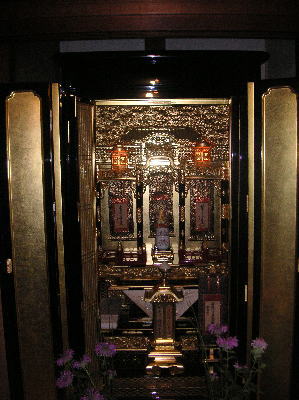
|
This is the Butsudan of our family.
Butsudan is a shelf where there is an image of Buddha, wooden carving or
paper scrawl, the names of the deceased members of the family, tea, water,
rice, etc.
Before the Butsudan, there is a small table, on which we decorate flowers,
and an incense burner is set.
The doors of the Butsudan are opened in the morning, and closed at night.
There are some types of Butsudans. In our Jodo-Shinshu sect, we use gold
type shelf. |
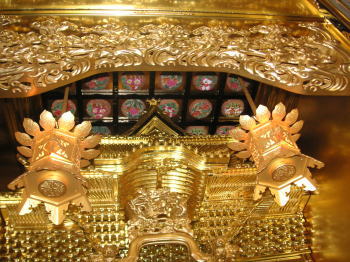
|
The upper part of the Butsudan.
You see the ceiling, where pictures are drawn. Mostly flowers or birds.
Two small lanterns are hanging from the ceiling. |
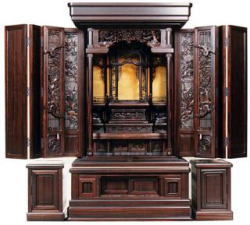
|
Another type of Butsudan is a wooden type, which is made with very hard
wood like rosewood or ebony. |
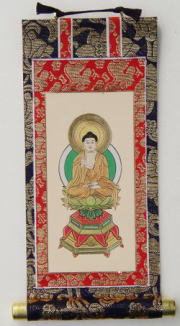
|
The image of Buddha |
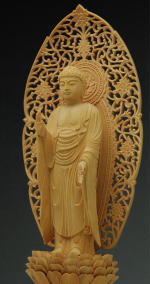
|
Wooden Buddha |
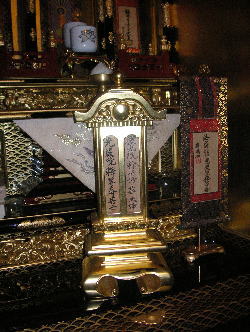
|
When somebody passes away, a new name is given. The priest gives the name,
thinking of the life, personality of the person. The name is written on
a small board called Ihai, but when there are many names, those names are
set in a case.
This golden case is the one. Inside, there are many narrow name boards,
and depending on the date of death, I change the order. |
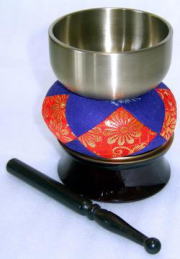
|
In the morning I say some sutra, ringing this small bell. |
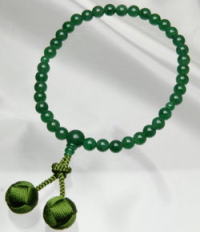 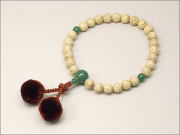
|
We use Juzu, like Rosario.
Left: Jade juzu for ladies
Right: Linden nut Juzu for men
We can use many kinds of material like crystal, opal, ebony, etc. |
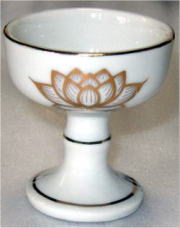 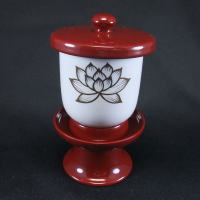
|
Left: rice bowl for Buddha
Right: Tea cup
Every morning, we offer rice, tea, water. |
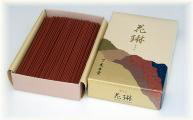
|
A box of incense sticks |
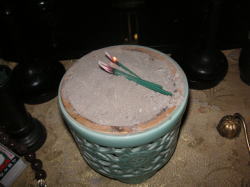
|
Every morning we burn incense. |
Grave of our family
|
|
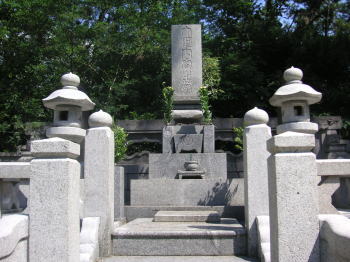
|
Our family grave is in the pine forest near by.
Three generations before my husband sleep here. We sometimes visit here
and clean, change flowers, and burn incense. |
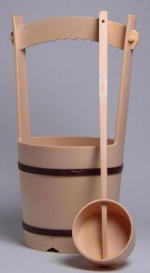
|
We use this kind of water bucket then. |
Obon ritual
|
|
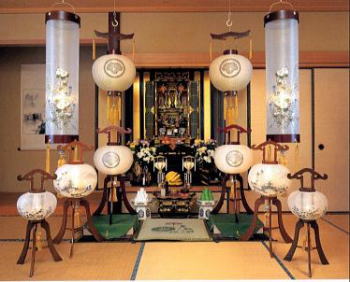
|
Obon is a very special ceremony for families in Japan.
Like this photo, we decorate many lanterns before the Butsudan. During
Obon days, our ancestors come home and stay, and eat with family.So, all
the members of the family get together.
Recently, this custom is going to disappear.
It is a sad thing, because the family is the base of Japanese culture. |
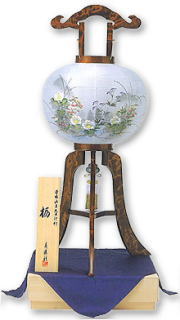
|
Lanterns are beautiful.
Gihu and Yame are the two biggest cities to produce paper lanterns.
The designs are sometimes flowers, and sometimes are family crests.
This photo is a silk lantern, and when the light inside is lit, it is so
beautiful. |
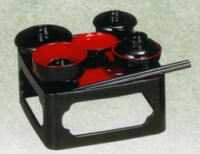
|
The table for the ancestors. Very small bowls and plates. Every morning
of Obon days, we make special meal (vegetarian meal), and we enjoy eating
together. |
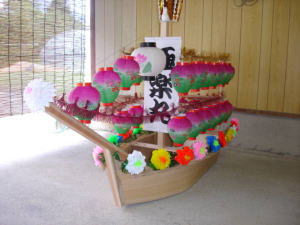
|
At night of August 15, the ancestors leave again. For the person who died
this year, a special boat is made. It is decorated with many lanterns,
and some food is put in the boat.
The dead must go far, so we offer them meals.
This boat is flown in the sea. |
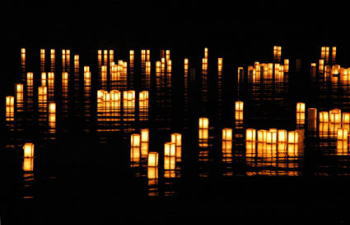
|
These lanterns are made to send the ancestors off. On sea or river, we
float these paper lanterns. The lights guide the dead back to the other
world. |

|
In Kyoto, this is the famous Daimonji-yaki,
on the last day of Obon. On the mountain side, a big Chinese letter meaning
"Big" appears.
These lights also guide the dead back to the place which they belong to
now.
In Karatsu, in the small mountain village Nanayama they build fires to
make a big fire of Chinese letter "nana" on every 7th day of
the month, Obon, new year. "Nana" means "seven".
I cannot take pictures of this big nana with my small camera, so please
forgive me. |
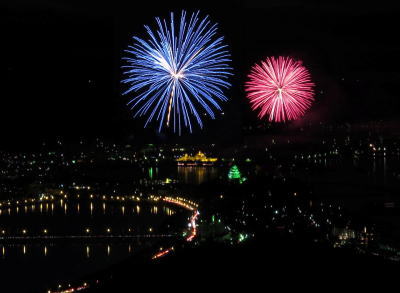
|
Sometimes, to send the dead off, fire works are set.
This photo was taken by Kunihisa Matsuo, from the top of Mount Kagami in
Karatsu City.
Do you see Karatsu Castle lighted up green in the center of the photo?
We have several fire-work festivals during the summer. |
|
|